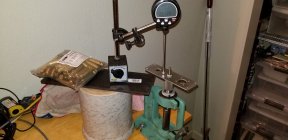OK guys, here is my procedure with the straight Hornady L-N-L gauge with the current plastic push rod. Using this procedure, typically 4 times, I will get results within about .0015 three of four times.
PREP
Make sure your chamber is CLEAN. No carbon or dirt or left-over foam residue.
Make sure the bullets you are using are typical of your lot. (Base to ogive can vary by .005" with some brands). Measure 10 bullets and select a typical one.
Make sure the modified case has adequate clearance. Neck turn the case if necessary. With wildcats it's not a bad idea to make your own modified case. LINK:
Our friend Gavin Gear has just released an excellent video showing how to make a threaded Modified Case for use with the Hornady Lock-N-Load Overall Length Gauge. You can watch Gavin make a Modified Case start to finish in the video below: Video Shows How to Drill and Tap Modified Case <iframe...

bulletin.accurateshooter.com
Start procedure
Thread the modified case onto tool. Make sure it is screwed all the way down (and recheck this for repeat procedures)
Insert the tool into the action, checking to make sure the bullet is not badly tilted.
Push the tool fairly firmly, and maybe rotate it a few degrees to ensure the modified case is seated at the end of the chamber. This is important -- I have seen MANY guys mess up because the tool wasn't fully seated right.
Push the gray plastic shaft
gently towards the muzzle. Keep it STRAIGHT. Go SLOW. Use light pressure. STOP when you feel resistance.
After feeling resistance, retract the pusher a small bit then TAP gently 2-3 times. This will help the bullet align if it is not straight.
After the tapping, push again gently. Sometimes the bullet will move forward a bit. don’t push too hard.
Retract the tool. Most of the time the bullet will come out with the tool. If it sticks in the chamber (maybe 20% of time), tilt the gun vertical (muzzle up) and the bullet should drop out with a slight bump on buttpad.
RESULTS
I usually run this test 4 times. I will typically get the SAME measurement within .001-.002" 3 of 4 times. I use that distance as my repeatable "first touch" point, though I am guessing I am .002" or so into the lands because there may be a tiny dot mark on bullet jacket (really tiny -- NOT a stripe).
But the important point is that this IS repeatable. I have taught this method to a few shooters at my club, including a guy who was cursing about his Hornady tool. His problem was that he was working too fast, and pushing way too hard on the plastic pusher. After showing him my technique we did 7 measurements in his 30BR and 5 of 7 were within .002.











